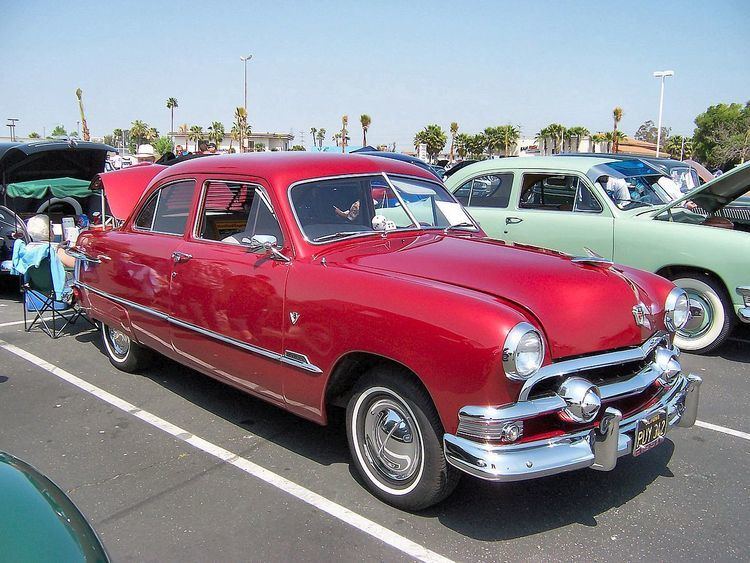 | ||
The Ford Custom is an automobile which was produced by Ford in the United States, Canada, Europe and Australia in certain years from 1949 to 1981.
Contents
Custom and Custom Deluxe (1949-1955)
For the 1949 model year, the Custom nameplate was used for the top trim level in Ford's range automobile. It was part of the completely new redesign of Ford cars after the war. In 1950, it had a 114-inch wheelbase and 196.8-inch overall length. For 1950 the name was changed to Custom Deluxe and then to Customline for 1952 when it moved to the midrange position between the new Mainline and Crestline models.
Custom and Custom 300 (1957-1959)
The Custom name returned for the 1957 model year along with a new Custom 300 series, these two models sitting below the Fairlane and Fairlane 500. The base Custom was the bottom-rung model, whose primary customers were fleet buyers. The Custom 300 was a step up and intended for value-conscious customers. The Custom and Custom 300 generally replaced the fleet-oriented Mainline and mid-range Customline, respectively, from 1956.
The Custom 300 became the base model for 1958, but was dropped from the range for 1960.
Custom and Custom 500 (1964-1981)
From 1960-1963, the "Custom" and number-affixated variant nameplates were absent from the lineup, replaced by either Fairlane or base Galaxie models. Base 1963 Fords were badged as the Ford 300.
The Custom nameplate reappeared in 1964, once again on the economy line of models. As in 1957-1958, the Custom range consisted of two series: a base Custom range and a slightly-better trimmed Custom 500 series. Most Customs were sold to police and taxi fleets during the 1960s, although anyone who wanted basic, no-frills transportation with the convenience of a full-sized car could purchase one, while the Custom 500 was more geared toward budget-conscious buyers who wanted a low-cost automobile but not a stripped model. Generally, the Custom 500 models were differentiated from their less-expensive stable mates by a chrome trim fender strip, roof drip moldings, carpeting (although by the late 1960s, even base Customs had carpeting), a somewhat upgraded cloth-and-vinyl upholstery and minor convenience items.
Most Customs and Custom 500s were fitted either with a base inline six-cylinder engine or a small-block V8 engine (289 cid in the early years, up to 351 by the mid- to late-1970s), although the full range of large-block V8 engines, up to the 425-horsepower 427 V8, and transmissions (from overdrive and 4-speed manual to SelectShift automatic) were available for police customers and performance-oriented customers who wanted the lightest car possible. As late as 1972, a powertrain combination of a six-cylinder engines and three-speed manual transmission was standard on the Custom and Custom 500 range; all V8-powered engines had SelectShift made standard for the 1972 model year. The six-cylinder engine/manual transmission power team was shelved for 1973; all full-sized Fords from 1973 onward, including the Custom 500, had a V8 engine (starting with the 351 cubic-inch block) and SelectShift transmission standard.
The Ford Custom was dropped after the 1972 model year, although the Custom 500 continued for several more years. Starting in 1975, all big Fords were restyled and grew in size. From that time until 1978, the car was only available as fleet vehicle and wasn't even featured in sales catalogues. The Custom 500 line continued from 1979 until 1981 in Canada. In the United States, the Custom 500 was renamed LTD "S."
The companion station wagon series sold with Custom and Custom 500 trim was the Ranch Wagon. Like the coupe and sedan models, these cars were intended for fleet buyers.
1979-1981 (Canada only)
The 1979-1981 Custom 500s for the Canadian market were restyled using the Panther platform and had the base-model 1979 Ford LTD grill (with single rectangular headlights and inboard parking lights on a grill distinct from the upper-trimmed LTD Landau/Crown Victoria). Base powerteam in 1979 was the 302 cubic-inch V8 (with various 302 and 351-cid V8s available) and SelectShift transmission. For 1980, to meet EPA CAFE standards, a 255 cubic-inch V8 was made standard, with the 302 and 351 V8 engines optional.
Production
Approximately 7,850,000 full-size Fords and Mercurys were sold over 1969-78. This makes it the tenth best selling automobile platform in history.
Ford Custom 500s in film
Marion Crane, played by Janet Leigh, traded a black 1956 Ford for a white 1957 Ford Custom in the Alfred Hitchcock film Psycho.
A Ford Custom 500 was used as the family car in The Wonder Years from mid-Season 3 onwards
A brown 1971 Custom 500 4-door sedan with a blue interior, equipped with a 429 Police Interceptor/Cobra Jet engine and black steel wheels with Cooper Tire Wide Runner Polyglas tires, appeared in the 1973 Burt Reynolds film White Lightning and is perhaps the most famous Custom 500 ever. Unusually, scenes of the movie depict the cars (several were wrecked during filming, including the barge jumping scene) with either a manual or automatic transmissions.
A blue 1973 Ford Galaxie "460 Interceptor" was used in the movie "THE DRIVER" 1978. The producers chose the 460 Interceptor for its power and to show lots of burning rubber on screen. The Interceptor was chosen to make the police chase scenes lifelike. The chase scenes in the movie were compared to the movie "Bullitt".
Australian production
The Ford Custom Fordor was produced in Australia from September 1949, and Australian content on the locally produced Custom had reached 80% by 1950. A coupe utility variant was also offered by Ford Australia, initially as the Ford Coupe Utility, and later as the Ford De Luxe Coupe Utility.
The 1959 model North American Custom 300 was also produced by Ford Australia from September 1959. Offered only as a four-door sedan and only with a 332 cu in (5.4 L) V8 engine, it was given a mild makeover in late 1960 which included the grille design from the 1959 Canadian Meteor. The facelifted model continued in production through to 1962.
